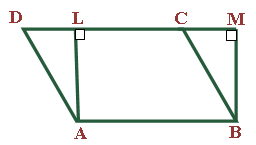Area of Parallelograms













Area of Parallelograms
Area of Parallelograms: Area of a parallelogram is caluculated as the product of base and the corresponding height.
In the figure ABCD is a parallelogram where AL Area of parallelogram ABCD = Base X height = AD X CM = CD X AL
|  |
Theorem 1 The area of a parallelogram is the product of its base and the corresponding altitude.
Given A parallelogram ABCD in which AB is the base and AL the corresponding altitude. To prove Construction Draw BM Proof Since
Hence, |  |
Illustration: I n the given figure, ABCD is a parallelogram, AL ⊥ DC and CM ⊥ AD. If AB = 14 cm. AL = 10 cm and CM = 7 cm, find AD.
Area of paralleogram ABCD = DC × AL (Taking base as DC and Height as AL ) Area of paralleogram ABCD = AB × AL (AB = DC as opposite side of the parallelogram are equal) Therefore, Area of paralleogram ABCD = 14 × 10 ……(1) Taking the base of Parallelogram ABCD as AD the height will be CM Area of paralleogram ABCD = AD × CM (taking base as AD and height as CM) Area of paralleogram ABCD = AD × 7 ……(2) Since equation 1 and 2 both represent the Area of the same Parallelogram ABCD , both should be equal. Hence from equation (1) and (2), This means that, 14 X 10 = AD X 7 AD X 7 = 14 X 10 |  |
The base of the parallelogram is thrice its height. If the area is 192 | |||
| Right Option : C | |||
| View Explanation | |||
Find the area of the parallelogram with the base of 4 cm and height of 5 cm. | |||
| Right Option : B | |||
| View Explanation | |||
The area of parallelogram FEBA ___________ where BC is perpendicular to DE in the following figure.
| |||
| Right Option : B | |||
| View Explanation | |||
Students / Parents Reviews [10]
I have spent a wonderful time in Abhyas academy. It has made my reasoning more apt, English more stronger and Maths an interesting subject for me. It has given me a habbit of self studying

Yatharthi Sharma
10thIt has a great methodology. Students here can get analysis to their test quickly.We can learn easily through PPTs and the testing methods are good. We know that where we have to practice

Barkha Arora
10thAbhyas is a complete education Institute. Here extreme care is taken by teacher with the help of regular exam. Extra classes also conducted by the institute, if the student is weak.

Om Umang
10thMy experience with Abhyas academy is very good. I did not think that my every subject coming here will be so strong. The main thing is that the online tests had made me learn here more things.

Hiya Gupta
8thAbhyas Methodology is very good. It is based on according to student and each child manages accordingly to its properly. Methodology has improved the abilities of students to shine them in future.

Manish Kumar
10thIt was a good experience with Abhyas Academy. I even faced problems in starting but slowly and steadily overcomed. Especially reasoning classes helped me a lot.

Cheshta
10thMy experience with Abhyas is very good. I have learnt many things here like vedic maths and reasoning also. Teachers here first take our doubts and then there are assignments to verify our weak points.

Shivam Rana
7thAbout Abhyas metholodology the teachers are very nice and hardworking toward students.The Centre Head Mrs Anu Sethi is also a brilliant teacher.Abhyas has taught me how to overcome problems and has always taken my doubts and suppoeted me.

Shreya Shrivastava
8thA marvelous experience with Abhyas. I am glad to share that my ward has achieved more than enough at the Ambala ABHYAS centre. Years have passed on and more and more he has gained. May the centre flourish and develop day by day by the grace of God.

Archit Segal
7thIt was good as the experience because as we had come here we had been improved in a such envirnment created here.Extra is taught which is beneficial for future.

